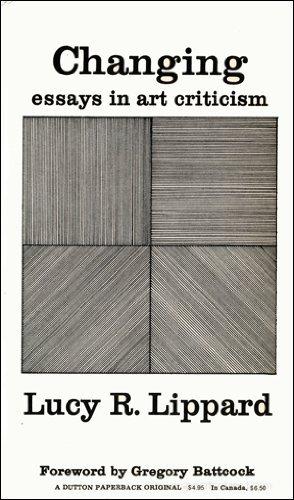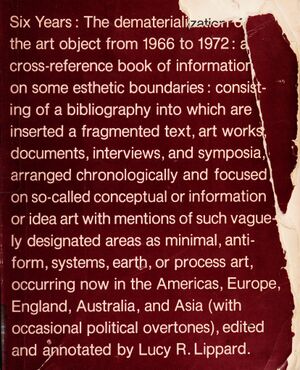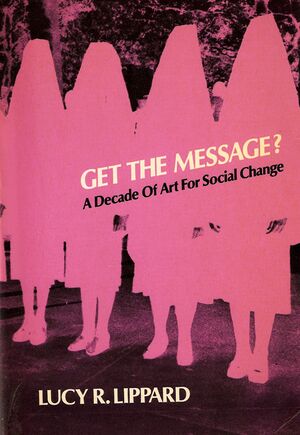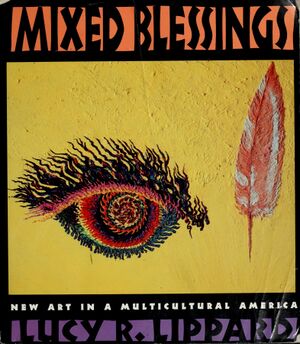Difference between revisions of "Lucy R. Lippard"
(→Books) |
|||
| Line 61: | Line 61: | ||
** ''Eva Hesse'', México: Alias, 2017, 357 pp. {{es}} | ** ''Eva Hesse'', México: Alias, 2017, 357 pp. {{es}} | ||
| − | * ''From the Center: Feminist Essays on Women's Art'', New York: E.P. Dutton, 1976. [https://sci-hub.st/10.2307/776224 Excerpt]. | + | *{{a|Lippard1976}}''From the Center: Feminist Essays on Women's Art'', New York: E.P. Dutton, 1976. [https://sci-hub.st/10.2307/776224 Excerpt]. |
* ''I See / You Mean'', Los Angeles: Chrysalis Books, 1979; new ed., afterw. Susana Torre, ed. Jeff Khonsary, Los Angeles: New Documents, 2021, 224 pp. Experimental novel. [https://new-documents.org/books/lucy-lippard-i-see-you-mean] | * ''I See / You Mean'', Los Angeles: Chrysalis Books, 1979; new ed., afterw. Susana Torre, ed. Jeff Khonsary, Los Angeles: New Documents, 2021, 224 pp. Experimental novel. [https://new-documents.org/books/lucy-lippard-i-see-you-mean] | ||
Revision as of 17:11, 13 February 2023
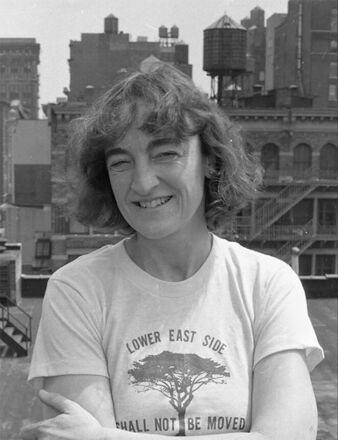 | |
| Born |
April 14, 1937 New York City, United States |
|---|---|
| Web | Aaaaarg, Wikipedia |
Lucy Rowland Lippard (1937, New York City) is an art historian, curator, writer and activist. As a critic, Lippard is best known for her study of conceptual art in Six Years: the Dematerialization of the Art Object from 1966 to 1972 and for her writing on feminist art and politically engaged art. Lippard has curated over 50 exhibitions and currently resides in Galisteo, New Mexico.
Born in New York City in 1937, Lippard earned a B.A. from Smith College in 1958 and an M.A. in 1962 from New York University's Institute of Fine Arts. In the 1960s she began writing art criticism for the journals Art International and Artforum. In 1966 she curated the landmark exhibition Eccentric Abstraction at the Fischbach Gallery in New York City. Lippard then curated the first of four defining conceptual art exhibitions that became known as her "numbers" shows, each titled after the populations of the cities in which they took place, with catalogs in the form of a set of 10 x 15 cm index cards. Opening at the Seattle Art Museum in 1969, 557,087 was followed by 955,000 in Vancouver, Canada, a few months later. 2,972,453 was held at the Centro de Arte y Comunicacíon in Buenos Aires in 1971 and c.7500 opened in Valencia, California, in 1973-1974 before traveling to several other venues in the United States and Europe.
Lippard's first book, The Graphic Work of Philip Evergood was published in 1966, followed by Pop Art the same year, and a collection of her early essays, Changing, in 1971. Six Years: The Dematerialization of the Art Object (1973) and From the Center: Feminist Essays on Women's Art (1976) documented the emergence of conceptual art and the early years of feminist art respectively. In 1976 Lippard published her seminal book on the life and work of Eva Hesse.
Between 1977 and 1978 Lippard lived on a farm in Devon, England, and worked on a novel, The First Stone, about the role of politics in the lives of three generations of women. During her walks across the English countryside she became interested in landscape art and conceived of her book Overlay: Contemporary Art and the Art of Prehistory which was subsequently published in 1983. Other books include Get the Message?: A Decade Of Art For Social Change (1984), Ad Reinhardt (1985), and Mixed Blessings: New Art in a Multicultural America (1990). Lippard has also written regular columns on art and politics for the Village Voice, In These Times and Z Magazine, and has been a contributing editor of Art in America.
Lippard was radicalized during a trip to Argentina in 1968 when she was invited to be a juror at the Museo Nacional de Bellas Artes in Buenos Aires. On her return to the United States she became heavily involved in anti-war activities and the Art Workers' Coalition. She is a co-founder of several feminist and artist organizations including the feminist collective Heresies, which produced Heresies: A Feminist Journal on Art and Politics from 1977-1992, Ad Hoc Women Artists, Alliance for Cultural Democracy, Artists Call Against U.S. Intervention in Central America, Women's Action Coalition, and Women's Art Registry. In 1976 she was a founder of Printed Matter, a New York nonprofit dedicated to producing artists' publications. She also worked closely with Franklin Furnace, an artist-run space devoted to the promotion of artists' books, installation art, and video and performance art, and served on the organization's International Committee.
Lippard has been a visiting professor at the School of Visual Arts, the University of Colorado, Boulder, and the University of Queensland, Australia, and was Eminent Artist in Residence at the University of Wyoming Department of Art in 2015. She has received honorary doctorates in fine arts from Maine College of Art, the Massachusetts College of Art, Moore College of Art, San Francisco Art Institute, and others, and awards including a Guggenheim Fellowship, two National Endowment for the Arts grants in criticism, the Smith College Medal, the ArtTable Award for Distinguished Service to the Visual Arts, and the Bard College Center for Curatorial Studies Award for Excellence.
Lippard has lived in New Mexico since 1992 and works as a freelance writer and speaker. (Source)
Publications
Books
- The Graphic Work of Philip Evergood, New York: Crown, 1966.
- Lippard, et al., Pop Art, New York: Praeger, 1966, 216 pp. With contributions by Lawrence Alloway, Nancy Marmer, and Nicolas Calas.
- Pop art, trans. Wim Gijsen, The Hague: Gaade, 1966, 216 pp. (Dutch)
- Pop art, trans. Roberto Sanesi, Milan: Gabriele Mazzotta, 1967, 256 pp; repr., Milan: Rusconi, 1989, 215 pp. (Italian)
- Pop Art, trans. Milica Drašković, Belgrade: Jugoslavija, 1967, 215 pp; 2nd ed., Belgrade, 1977, 215 pp. Review: Rus (ZU). (Serbo-Croatian)
- Poppu āto [ポップ・アート], trans. Atsushi Miyakawa, Tokyo: Kinokuniya Shoten, 1967, 216 pp; new ed., Tokyo: 洋販出版, 1993. (Japanese)
- Pop art, trans. Wolfgang Längsfeld and Margarete Längsfeld, Munich: Droemer Knaur, 1968, 236 pp. (German)
- Le pop art, Paris: Hazan, 1969, 216 pp; repr., Paris: Thames & Hudson, 1997. (French)
- A arte pop, Lisbon: Verbo, 1973, 240 pp. (Portuguese)
- Pop art, trans. Giōrgos Tassopoulos, Athens: Ekdoseis Hypodomē, 1984, 248 pp. (Greek)
- 露西.利帕, Pu pu yi shu [普普藝術], Taipei: 遠流, 1991, 264+[16] pp. (Chinese)
- El pop art, trans. Nicolas Calas, Barcelona: Destino, 1993, 216 pp. (Spanish)
- 팝 아트 : 예술과 상품의 경계에 서다, Seoul: 시공사, 2011, 265 pp. (Korean)
- editor, Surrealists on Art, Englewood Cliffs, NJ: Prentice-Hall, 1970, 213 pp.
- editor, Dadas on Art: Tzara, Arp, Duchamp and Others, Englewood Cliffs, NJ: Prentice-Hall, 1971, xii+178 pp. [1]
- Changing: Essays in Art Criticism, New York: Dutton, 1971, 320 pp.
- Six Years: The Dematerialization of the Art Object from 1966 to 1972; A Cross-Reference Book of Information on Some Esthetic Boundaries ..., New York: Praeger Publishers, 1973, xxii+272 pp; repr., new intro., University of California Press, 1997.
- Seis años: la desmaterializacion del objeto artístico de 1966 a 1972, trans. Luz Rodríguez Olivares, Madrid: Akal, 2004, 378 pp. (Spanish)
- Eva Hesse, New York: New York University Press, 1976.
- Eva Hesse, México: Alias, 2017, 357 pp. (Spanish)
- From the Center: Feminist Essays on Women's Art, New York: E.P. Dutton, 1976. Excerpt.
- I See / You Mean, Los Angeles: Chrysalis Books, 1979; new ed., afterw. Susana Torre, ed. Jeff Khonsary, Los Angeles: New Documents, 2021, 224 pp. Experimental novel. [2]
- Yo veo / Tú significas, trans. Paloma Checa-Gismero, Bilbao: Consonni, 2016, 233 pp. [3] (Spanish)
- with Charles Simonds, Cracking / brüchig werden, Cologne: Verlag der Buchhandlung Walther König, 1979, 126 pp. An artist's book about a woman archaeologist who in the process of an excavation is drawn into the imaginary world of simonds's little people, as created in his sculptures. [4] (German)
- Ad Reinhardt, New York: Harry N. Abrams, 1981, 216 pp.
- Overlay: Contemporary Art and the Art of Prehistory, New York: Pantheon Books, 1983.
- 원저자명, Obeorei [오버레이 : 먼 과거에서 대지가 들려주는 메시지와 현대미술에 대한 단상], trans. Hyeongmin Yun, Seoul: Hyeonsil Munhwa Yeongu, 2019, 343 pp. (Korean)
- Get the Message? A Decade of Art for Social Change, New York: E.P. Dutton, 1984, 343 pp, OL.
- Mixed Blessings: New Art in a Multicultural America, New York: Pantheon Books, 1990, vii+278 pp; new ed., New York: The New Press, 2000.
- A Different War: Vietnam in Art, Bellingham, WA: Whatcom Museum of History and Art, 1990.
- The Pink Glass Swan: Selected Essays on Feminist Art, New York: The New Press, 1995, viii+342 pp. TOC.
- The Lure of the Local: Senses of Place in a Multicentered Society, New York: New Press, 1998. Part 1 of 5.
- On the Beaten Track: Tourism, Art and Place, New York: New Press, 1999.
- Weather Report, Boulder, CO: Boulder Museum of Contemporary Arts, 2007.
- Undermining: A Wild Ride Through Land Use, Politics, and Art in the Changing West, New York: The New Press, 2014, 200 pp. Review: Meunier (Transatlantica).
- Pueblo Chico: Land and Lives in Galisteo since 1814, Santa Fe: Museum of New Mexico Press, 2020, 304 pp. Review: Warzel.
Catalogues
- "Number shows"
A series of four exhibitions named for the populations of the cities they were held in. Their catalogues are made up of collections of loose black-and-white index cards containing statements, documentation, and conceptual works by each artist, to be rearranged, filed, or discarded at will.
- 557,087, Seattle: Contemporary Art Council of the Seattle Art Museum, 1969, [95] cards. Consists of 95 10cm x 15cm index cards. Exh. held at the Seattle Art Museum Pavilion, 5 Sep-5 Oct 1969. About. [5]
- 955,000, Vancouver: Vancouver Art Gallery, 1970, [137] cards. Consists of 95 10cm x 15cm index cards from the previous show in Seattle with 42 new index cards added; in total 71 artists from North America and Europe participated. Exh. held at the Vancouver Art Gallery, 13 Jan-8 Feb 1970. [6] [7]
- 2,972,453, Buenos Aires: Centro de Arte e Communicacion, 1970, [43] cards. Consists of 43 cards; included only artists that were not part of the first two exhibitions held in Seattle and Vancouver. Exh. opened 4 Dec 1970. [8] [9] [10]
- c.7,500, Valencia, CA: California Institute of the Arts, 1973, [30] cards. Included only women artists. (incl. Wadsworth Atheneum, ICA Boston, Smith College, and Walker Art Center). Exh. held May 1973-Feb 1974 at the California Institute of the Arts, Valencia, CA. Afterwards traveled to six other venues: ICA Boston; Moore College of Art, Philadelphia; Wadsworth Atheneum, Hartford, CT; Walker Art Center, Minneapolis; Royal College of Art, London; Smith College Museum of Art, Northampton, MA. [11] [12]
- 4,492,040, ed. Jeff Khonsary, afterw. Lucy R. Lippard, Los Angeles and Vancouver: New Documents, 2012. Facsimile reprint of all four of the catalogues, with a new afterword by Lippard. [13]
- Other
- Sniper's Nest: Art That Has Lived with Lucy R. Lippard, ed. David Frankel, Annandale-on-Hudson, NY: Center for Curatorial Studies/Bard College, 1996, iv+104 pp.
Editor
- co-editor, Heresies: A Feminist Publication on Art and Politics, New York: Heresies Collective, 1977-1993.
Essays (selection)
- "Eccentric Abstraction", Art International 10:9 (Nov 1966); upd. in Lippard, Changing: Essays in Art Criticism, 1971, pp 98-111.
- "Change and Criticism: Consistency and Small Minds", Art International 9:9, New York, Nov 1967; repr. in Lippard, Changing: Essays in Art Criticism, 1971, pp 23-34.
- with John Chandler, "The Dematerialization of Art", Art International 12:2, New York, Feb 1968, pp 31-36; repr. in Lippard, Changing: Essays in Art Criticism, 1971, pp 255-276; repr., shortened, in Conceptual Art: A Critical Anthology, eds. Alexander Alberro and Blake Stimson, MIT Press, 1999, pp 46-50. Written in late 1967. [14]
- "La desmaterialización del arte", trans. Jaime Arrambide, in Sistemas, Acciones y Procesos, 1965-1975, ed. Rodrigo Alonso, PROA, 2011, pp 106-116. (Spanish)
- "10 Structurists in 20 Paragraphs", in Minimal Art, ed. Enno Develing, The Hague: Haags gemeentemuseum, 1968; repr. in Theories of Contemporary Art, ed. Richard Hertz, Prentice-Hall, 1985, pp 207-214. [15] [16]
- "10 Strukturisten in 20 Absätzen", in Minimal Art. Eine kritische Retrospektive, ed. Gregor Stemmrich, Dresden, 1995, pp 309-323. [17] (German)
- "The Art Workers' Coalition: Not a History", Studio International 180, Nov 1970; repr. in Lippard, Get the Message? A Decade of Art for Social Change, E.P. Dutton, 1984, pp 10-19, PDF. [18] [19]
- "The Pains and Pleasures of Rebirth: Women's. Body Art", Art in America 64:3, May/Jun 1976, pp 73-81.
- Lyusi Lippard (Люси Липпард), "Bol' i radost' rozhdeniya zanovo: yevropeyskiy i amerikanskiy zhenskiy bodi-art" [Боль и радость рождения заново: европейский и американский женский боди-арт], in Gendernaya teoriya i iskusstvo. Antologiya: 1970—2000 [Гендерная теория и искусство. Антология: 1970—2000], ed. L.M. Bredikhina (Л.М. Бредихина), Moscow: ROSSPEN, 2005, pp 67-85. Publisher. (Russian)
- "The Pink Glass Swan: Upward and Downward Mobility in the Art World", Heresies 1, Jan 1977, pp 82-87; repr. in Lippard, The Pink Glass Swan: Selected Essays on Feminist Art, New York: The New Press, 1995, pp 117-127.
- "The Artist's Book Goes Public", Art in America, Jan-Feb 1977; repr. in Lippard, Get the Message? A Decade of Art for Social Change, E.P. Dutton, 1984, pp 48-52; repr. in Artists' Books: A Critical Anthology and Sourcebook, ed. Lyons, 1985, pp 45-48.
- "Sweeping Exchanges: The Contribution of Feminism to the Art of the 1970s", Art Journal 40(1-2): "Modernism, Revisionism, Plurism, and Post-Modernism", 1980, pp 362-365.
- Lyusi Lippard (Люси Липпард), "Sparring-obmen: Vklad feminizma v iskusstvo 1970-kh gg" [Спарринг-обмен: Вклад феминизма в искусство 1970-х гг], in Gendernaya teoriya i iskusstvo. Antologiya: 1970—2000 [Гендерная теория и искусство. Антология: 1970—2000], ed. L.M. Bredikhina (Л.М. Бредихина), Moscow: ROSSPEN, 2005, pp 162-175. Publisher. (Russian)
- "Un changement radical: la contribution du féminisme à l'art des années 1970" in La rébellion du Deuxième Sexe – L’histoire de l’art au crible des théories féministes anglo-américaines (1970-2000), ed. Fabienne Dumont, Paris: Les presses du réel, 2011. (French)
- "Give and Take: Ideology in the art of Suzanne Lacy and Jerry Kearns", in Art & Ideology, New York: New Museum of Contemporary Art, 1984, pp 29-38. Catalogue essay.
- "Trojan Horses: Activist Art and Power", in Art After Modernism: Rethinking Representation, ed. Brian Wallis, New York: David R Godine, 1984. [20] [21]
- "Trojanski konji: aktivistična umetnost in moč", trans. Janko Lozar, Likovne besede, 2000, pp 176-190. (Slovenian)
- "Caballos de Troya : arte activista y poder", in Fotografía y activismo, ed. Jorge Luis Marzo, Barcelona: Gustavo Gili, 2006, pp 55-82. (Spanish)
- "Skärningspunkter / Intersections", trans. Tua Waern, in Flyktpunkter, Stockholm: Moderna museet, 1984, 11-29. (Swedish)/(English)
- "Conspicuous Consumption: New Artists' Books", in Artists' Books: A Critical Anthology and Sourcebook, ed. Lyons, 1985, pp 49-59.
- "Andres Serrano: The Spirit and The Letter", Art in America, Apr 1990, 238-245.
- "Doubletake: The Diary of a Relationship with an Image", Third Text 5:16-17, 1991, pp 135-144. [22]
- "Reacción tardía: diario de una relación con una imagen ", in Poéticas del espacio : antología crítica sobre la fotografía, ed. Steve Yates, Barcelona: Gustavo Gili, 2002, 245-262. (Spanish)
- "Escape Attempts", in Reconsidering the Object of Art: 1965–1975, eds. Ann Goldstein and Anne Rorimer, Los Angeles: Museum of Contemporary Art, and Cambridge, Mass.: MIT Press, 1995. [23]
- "Looking Around: Where We Are, Where We Could Be", in Mapping the Terrain: New Genre Public Art, ed. Suzanne Lacy, Seattle, WA: Bay Press, 1995, pp 114-130.
- "Mirando alrededor: dónde estamos y dónde podríamos estar", trans. Paloma Blanco and Jesus Carrillo, in Modos de hacer: arte crítico, esfera pública y acción directa, eds. Paloma Blanco, et al., Ediciones Universidad de Salamanca, 2001, pp 51-71, PDF. (Spanish)
- "On and Off the Map", in Lippard, The Lure of the Local, 1997, pp 75-82.
- "Biting the Hand: Artists and Museums in New York since 1969", in Alternative Art, New York, 1965-1985: a Cultural Politics Book for the Social Text Collective, ed. Julie Ault, University of Minnesota Press, with New York: Drawing Center, 2002, pp 79-120. Publisher.
- "Time Capsule", in Art and Social Change: A Critical Reader, eds. Will Bradley and Charles Esche, London: Tate Publishing, 2007, pp 408-421.
- "Curating by Numbers", Tate Papers 12: "Landmark Exhibitions", London: Tate, Autumn 2009.
- "In the Cards", in Lippard, 4,492,040, ed. Jeff Khonsary, Los Angeles and Vancouver: New Documents, 2012.
- "Foreword: Curating on the Cutting Edge", in Kate Bonansinga, Curating at the Edge: Artists Respond to the U.S./Mexico Border, University of Texas Press, 2014, pp vii-xii.
Interviews, conversations
- Blumenthal/Horsfield, "Lucy Lippard 1974: An Interview", 1974, 25 min. Video. VDB.
- Blumenthal/Horsfield, "Lucy Lippard 1979: An Interview", 1979, 64 min. Video. VDB.
- Lynn Hershman, "Interview with Lucy Lippard", San Francisco, 1987. Video, 19 min.
- Parallaxis: Fifty-Five Points to View: A Conversation with Lucy R. Lippard and Rina Swentzell, Denver, CO: Western States Arts Federation, 1996.
- Julie Ault, "Interview with Lucy R. Lippard on Printed Matter", Dec 2006.
- Hans Ulrich Obrist, "Lucy Lippard", in Obrist, A Brief History of Curating, Zurich: JRP / Ringier, 2008.
- Khans Ulrikh Obrist (Ханс Ульрих Обрист), "Intervyu s Lyusi Lippard" [Интервью с Люси Липпард], in Obrist, Kratkaya istoriya kuratorstva [Краткая история кураторства], Moscow: Ad Marginem, 2012. (Russian)
- "Lucy Lippardová", in Hans Ulrich Obrist, Stručná historie kurátorství, Kutná Hora: Galerie Středočeského kraje GASK, 2012, pp 165-196. (Czech)
- Sue Heinemann, "Oral history interview with Lucy Lippard", Washington, DC: Smithsonian Institution, 2011.
- "Number Shows: Process of Attrition. Lucy R. Lippard in Conversation with Antony Hudek", Flash Art 281, Nov-Dec 2011; repr. as "Lucy R. Lippard in Correspondence with Antony Hudek", in Cornelia H. Butler, From Conceptualism to Feminism: Lucy R. Lippard's Numbers Shows, 1969-74, London: Afterall Books, 2012, pp 70-77.
- "Očíslované výstavy. Proces postupného úbytku", Flash Art CS 23-24, Apr-Aug 2012. (Slovak)
- "Lucy R. Lippard", Artforum, 2012. Video, 6 min.
- Ian Wallace, "Critic Lucy Lippard on Trading Conceptual Art for Environmental Activism", Artspace, May 2014.
- Sabine Mirlesse, "Conversation avec Lucy R. Lippard", trans. Annie Pérez, Cahiers du Musée national d'art moderne 146, 2018, pp 44-51. [24] [25] (French)
- Michael Abatemarco, "The road to Galisteo: Arts writer, critic, and activist Lucy Lippard", Pasatiempo, Jan 2021.
Documentaries
- Artists’ Call to Central America: Lucy Lippard and Art for a Cause, Paper Tiger Television, 1984, 28 min. A show documenting a two week benefit festival of performance art held in January of 1984, curated and organized by Lucy Lippard.
Literature
- Julia Bryan-Wilson, "Lucy Lippard's Feminist Labor", ch. 4 in Bryan-Wilson, Art Workers: Radical Practice in the Vietnam War Era, University of California Press, 2009.
- Catherine Morris, Vincent Bonin (eds.), Materializing Six Years: Lucy R. Lippard and the Emergence of Conceptual Art, pref. Lucy R. Lippard, MIT Press, and New York: Brooklyn Museum of Art, 2012, 304 pp. Publisher. Reviews: Bury (Cassone), Tang (Artforum).
- Julia Bryan-Wilson, "Still Relevant: Lucy Lippard, Feminist Activism, and Art Institutions", pp 70-92.
- Cornelia H. Butler, et al., From Conceptualism to Feminism: Lucy R. Lippard's Numbers Shows, 1969-74, London: Afterall Books, 2012, 304 pp. TOC. Publisher.
- Sabeth Buchmann, "Curating with/in the System", OnCurating 26: "Curating Degree Zero Archive: Curatorial Research", Oct 2015. On Lippard's 'Number shows'.
- Genese Grill, "Re-Materialization, Remoteness, and Reverence: A Critique of De-Materialization in Art", Georgia Review 70:3, Fall 2016, pp 563-581; repr.," Caesura, Sep 2020; repr. in Grill, Portals: Reflections on the Spirit in Matter, Splice 2022.
- Celina Figueiredo Lage, Maria Gabriela Carvalho, "Get the message? Lucy R. Lippard após a desmaterialização da arte", Art Sensorium 7:2, Jul-Dec 2020. (Brazilian Portuguese)
- Karen Benezra, "Introduction", in Benezra, Dematerialization: Art and Design in Latin America, University of California Press, 2020.
See also
Links
- Lucy R. Lippard papers, 1930s-2010, bulk 1960-1990, Archives of American Art
- PAD/D
- PAD/D Collection at MoMA
